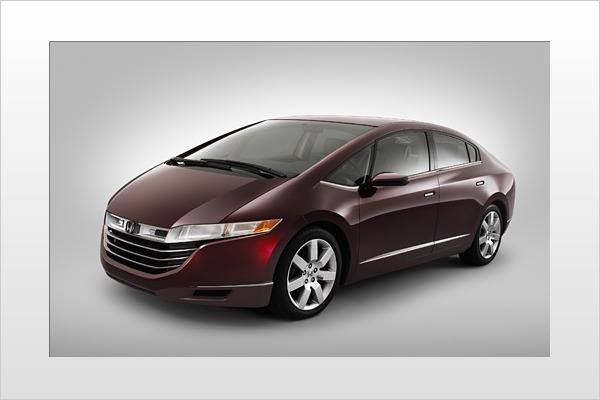
You still won't be able to buy one of Honda's $1-million-plus, hand-built FCX fuel-cell cars at your neighborhood dealership, but with an eye-popping new model coming out in 2008, the automaker wants to put far more on the street than the 15 that are in use now.
Honda's latest effort to bring a retail fuel-cell vehicle closer to reality has borne fruit as the IRS has declared the FCX eligible for a $12,000 federal tax credit.
The credits go to the vehicle's registered owner, and because Honda only leases its FCXs at this point, the tax dollars are pumped back into the automaker's coffers to help offset the fuel-cell program's development costs.
But the tax credit could be a big incentive if Honda were to chase increased visibility for the vehicle by selling heavily subsidized FCXs to various government and private fleet operations, as well as to the occasional Silicon Valley billionaire, Hollywood star, sports icon or music mogul with a big need to be the first on the block with wheels that don't rely on dead dinosaurs and that spill only distilled water from the tailpipe.
"We think the tax credit is a great third-party validation of what we're doing," said Honda spokesman Sage Marie. "People will hear about it and say 'Hey! This is a real car.'"
Basically, a fuel-cell vehicle is an electric car that gets its juice from an onboard electro-chemical generator rather than a big rechargeable battery. Electricity is produced in the fuel cell by combining hydrogen and oxygen and running the vapors through a catalyst.
No one over at American Honda headquarters in Torrance, California, is saying much about future plans for FCX retailing, and the company's spokespeople often use the word "sell" when they really mean "lease" or even "loan."
But with that caveat in mind, please note that Honda people do, regularly, talk about a time when the company will be "selling" the FCX.
The 2008 FCX, which should look a lot like the concept model Honda's been showing around, won't be available in big numbers and won't be rolled out nationally. Even though the vehicle can be built and will operate as a daily driver, there's that little issue of where the heck to refuel when the hydrogen tank runs dry.
The new FCX promises to be a good-looker, a huge improvement over today's minivanlike model. But without a hydrogen fueling infrastructure, no fuel-cell vehicle, regardless of its looks or the advanced technologies crammed under its skin, is ever going to be anything more than a really expensive, and immobile, monument to the green movement.
By most estimates, marketable fuel-cell vehicles with competitive features, performance and prices are a decade or more away (although General Motors insists it will have a retail model ready by 2010). A national hydrogen fueling system, which would cost billions to establish, is likely even further in the future.
Still, Honda's Marie says that the company wants to get more FCXs onto the public streets, and is eyeing increased retail activity next year in those areas of the country that have the few hydrogen filling stations that have been built.
Most of those stations are test sites, affiliated with fuel companies, government or university fuel-cell programs, and closed to the public.
But if Honda were to negotiate access deals for its FCX customers, it could market the fuel-cell vehicle in a big swath of coastal Southern California; parts of the Bay Area around San Francisco; the Sacramento area (home away from Hollywood for California Governor Arnold Schwarzenegger, a big hydrogen booster); Las Vegas; Washington, D.C.; and a few neighborhoods in South Florida, Connecticut, upstate New York and the Detroit area. (A list of hydrogen stations around the globe is available online at Fuel Cells 2000.)
"The car is still a long way from being mainstream, but this IRS ruling on the tax credit certainly helps Honda argue that it is moving another step in that direction," said Kevin Smith, Edmunds.com's editorial director.
Honda already has garnered approval of the FCX from California's tough Air Resources Board and from the federal Environmental Protection Agency. Both have certified it as a zero-emissions vehicle, or ZEV, and the EPA rates its range on a tank of hydrogen at 210 miles. Honda's fuel-cell vehicle also is the only one on the road that's been certified as meeting all federal crash safety standards.